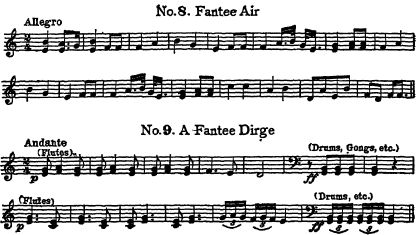Afro-American Folksongs - online book
A Study In Racial And National Music, With Sample Sheet Music & Lyrics.
| Share page | Visit Us On FB |
|
AFRO-AMERICAN FOLKSONGS |
||
 |
||
|
Specimens of African Music disclosing Elements Found in the Songs of the Negro Slaves in America.
No 1 A dram call from West Africa, utilized by Coleridge-Taylor in "Twenty, four Negro Melodies transcribed for the Piano" (Boston, Oliver Ditson Co). The specimen exhibits the rhythmical "snap" or "catch", an exaggerated use of which has produced "rag-time"; also the, fact that African drams are sometimes tuned— No. 2. The tones given out by a xanxe of the Zulus in the posesslon of the author; shows the pentatonic scale with two notes Strang' to the system at the end.- No. 8. A pentatonic melody from "Lbs Chant' et les Contesdee Ba-Hosga? by Henri Junod, utilized by Coleridge-Taylor, who remarked of it that'It was "certainly not unworthy of any compeser- from Beethoven downwards?- No. 4. A melody of the "Hottentots, quoted by Engel in his "Introduction to the Study of National Music". It is in the major mode with the fourth of the scale omitted. The all-pervasive "snap" is presentyas ft is in ~ No. 5 A Kaffir melody, also quoted by Engel; in the major mode CD) without the leading-tone.- No. 6. Music of a dance of the Dahomans heard at-the Columbian' Exhibition la Chicago in 189d, illustrating the employment of the flat seventh and cross' rhythms between singers and drummers-- No. 7. According to Bowdich ("Mission from Cape Coast Cas' tie to AshanteeV London, 1819), the Oldest air in his collection. Bowdich saysrl could trace it through four generations, but the answer made to my enquiries will give the best idea of its antiquity: 'It was made whjto the country was made1." It was played on the sanJkoy sv sfcde guitar. It demonstrates the use of thirds.- No.8. A Fantee sir from BowdichVMisslon, eter, show-ing thirds, fifths and the "snap?- No. 9. A Fantee dirge for flutes and instruments of percussion, Also from Bowdich, who says: "In venturing the Intervening and concluding bass-chord, I merely attempt to describe the castanets, gong-gongs, drums, etc, bursting in after the soft and mellow tones of the flutes; as if the ear was Hot to retain a vibration of the tweet ermelodyr |
||
|
[ 62 ] |
||